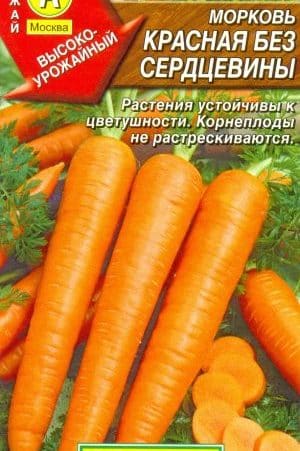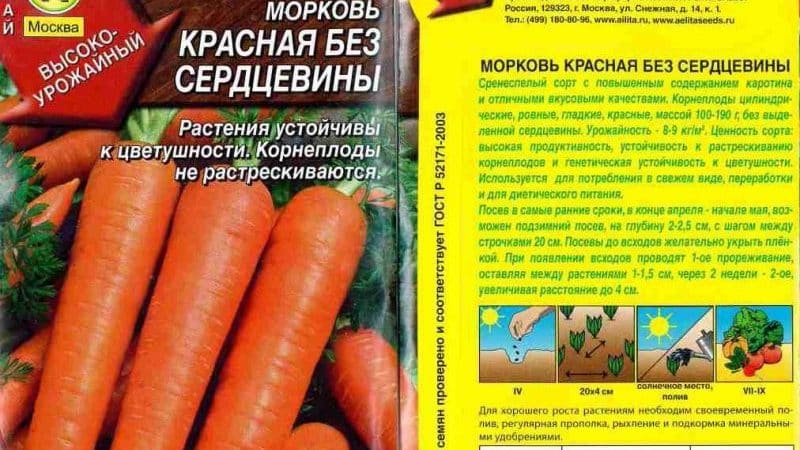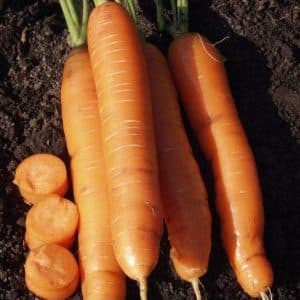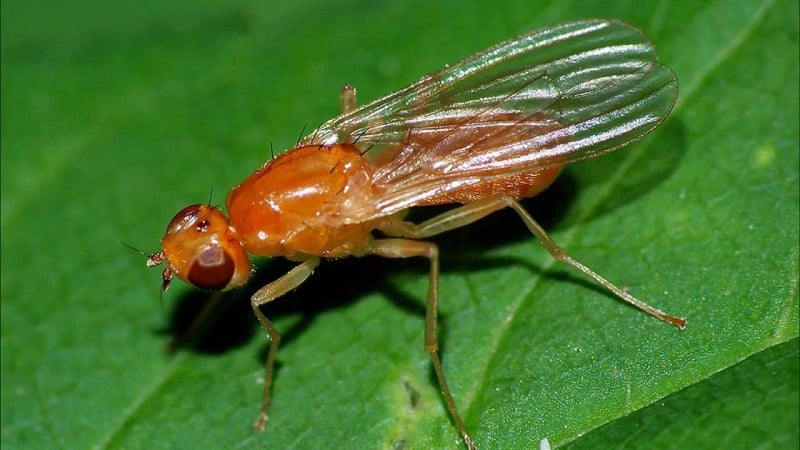Features of red carrots without core
The core, or xylem, is the woody part of the root crop, which gives it roughness and is poorly absorbed by the body. Heartless carrots are those whose xylem and outer parts look uniform. This property is characteristic of the Red carrot without core variety.
Description of the variety Red carrots without core
The mid-late variety was created in Germany. The originator is the breeding and seed production company Satimex Quedlinburg Handelsgen mbH. The variety is recommended for cultivation on private farms.

The above-ground part is represented by a rosette of semi-spreading leaves. The leaf blades are medium-dissected, long, green.
The average yield is 355 kg/area. The average weight of the root crop is 97 g.
The roots are long, cylindrical, with a slightly rough surface and a blunt tip. The core and pulp are colored the same, red.
The diameter of the core relative to the total diameter of the root crop is less than 25%. Intended for fresh consumption, for storage, and for juices.
The variety has a high degree of resistance to brown spot and carrot fly.
On average, heartless carrots contain:
- dry matter – 11.6%;
- total sugar – 6.4-7%;
- carotene – up to 0.017%.
The content of nutrients depends on growing conditions, weather and soil composition.
The main advantages and disadvantages of the variety
Red heartless is a highly productive variety.Carrots are distinguished by excellent taste - the variety has earned a fresh produce tasting rating of 5 points.
The downside is that fragile and delicate root crops are often damaged during harvesting, so the yield of marketable products is only 69.3%.
What is the difference from other varieties
Forms with a small core have greater early ripening, improved taste of root crops, and crack less in the ground.
Features of planting and growing
Large seeds have a greater supply of nutrients than small ones. With an even sowing depth, seedlings appear simultaneously. The more uniform the carrot sprouts, the larger the root crops will be.
Preparing for landing
Red heartless carrots are placed on the site in the second year after applying manure.
Before sowing, the seeds are sorted, disinfected with water at a temperature of +48°C for 20 minutes, and separated by specific gravity in a 5% solution of table salt. To accelerate growth and increase yield, seeds are treated with growth stimulants or a solution of microelements.
Before sowing, the seeds are scattered in a thin layer, then disinfected with a pale pink solution of potassium permanganate.
Soil requirements
Heartless carrots grow well on cultivated peat bogs, slightly acidic or neutral soils of light and medium texture. The arable layer should be loose and fertile - up to 30 cm. The depth of groundwater is 0.8-2.5 m.
Predecessors
Growing in one place for 4-5 years leads to the fact that carrots suffer from diseases and pests. Natural loss during storage increases by 10%, root crops are affected by phomosis, gray and white rot.
Precursors must have a developed root system to improve the soil structure.
The best predecessors are plants that, after harvesting, do not leave behind large crop residues: legumes, early cabbage, potatoes, cucumbers.
Dates, scheme and rules of planting

Sow into the ground at the end of April - beginning of May. Carrots grow well near onions, garlic, and beets.
If deep tillage was carried out before sowing, rolling is recommended. The optimal sowing depth is 1-2 cm. In dry weather, the beds are watered on the eve of sowing. To retain soil moisture, crops are covered with film or spunbond.
The optimal sowing time for obtaining an early harvest occurs when the soil warms up to +4...+5°C and humidity is 70-80%. If long-term storage is expected, carrots are sown 2-3 weeks after the onset of optimal conditions for planting.
Landing rules:
- seed sowing rate – 0.4-0.6 g/m²;
- sowing depth on light soils - up to 3 cm, on heavy soils - 1.5-2 cm.
Carrot seeds germinate slowly. At a soil temperature of +5°C, seedlings appear after 36 days, unless procedures have been carried out to accelerate germination.
The optimal temperature for seed germination is +20…+22°C. Under favorable conditions of temperature and humidity, seedlings appear in 10-15 days. In drought conditions, seedlings can withstand frosts down to –4°C.
2 weeks after germination, the first true leaf develops. The second and third leaves appear at intervals of 6-8 days. The most favorable temperature for the initial growth of Red Heartless Carrots is +18…+20°C.
Features of cultivation
After germination, it is important that the cool period lasts as long as possible.Under such conditions, the tap root of heartless carrots intensively develops, which determines the length of the root crop. Then the carrots enter the ripening stage and the roots gradually thicken.
Carrots move more quickly to the ripening stage at elevated temperatures during the post-emergence period, which lasts until mid-June. Under such conditions, the harvest will be early, but the root crops will not grow large.
Nuances of care
From the middle of the season, it is recommended to combine inter-row cultivation with hilling. Usually 1-3 hillings are carried out to cover small weeds with soil and prevent greening of root crops. When hilling, the risk of damage to root crops by early frosts is reduced.
Thanks to a powerful root system that penetrates deeply into the soil, carrots are drought-resistant.
Irrigation mode:
- During seed germination, red heartless carrots are watered often and little by little.
- During the development of the root crop, a dry period is required - abundant watering will lead to the growth of tops. Dry conditions stimulate the development of long roots.
- The need for moisture increases maximum during the growth period of the root crop - at the stage of 4-5 leaves.
Sudden changes in soil moisture are dangerous for carrots. Regular watering avoids warping and cracking of the fruit.
Thinning and weed control
Red heartless carrot seeds germinate slowly, so the seedlings quickly become overgrown with weeds.
The first weeding is carried out in the phase of 2-3 true leaves. On weed-free soils, one weeding may be sufficient; in heavily overgrown weeds, up to three weedings may be required.
Soil tillage at the beginning of the season is carried out carefully so as not to damage the taproot.
Thinning:
- In the phase of 2 true leaves, leave 2-3 cm between plants.
- After 2-3 weeks, 5-8 cm are left between root crops.
Row spacing when grown on ridges is weeded regularly at intervals of 10 days until the rows close.
Top dressing
Carrots respond poorly to mineral fertilizers, increased doses of which slow down seed germination. Missing nutritional elements are replenished with root and foliar fertilizers during the growth period.
Red carrots have a high need for potassium fertilizers - litter manure, potassium magnesium, potassium sulfate.
With a lack of boron, root crops crack. The non-deficient content of the element is 1 mg per 1 kg of soil. Boron is poorly absorbed by plants when excessive doses of nitrogen fertilizers are applied.
The microelements molybdenum, copper and manganese, which are important for the development of root crops, are poorly absorbed when the soil is highly acidic. For manganese deficiency, foliar fertilizing with manganese sulfate is useful. If there is a lack of copper, the soil surface is moistened with a solution of copper sulfate (3%) before sowing.
Disease and pest control

Carrots have common diseases with other plants of the Apiaceae family. Pathogens are transmitted by infected seeds, insects, and persist on plants.
Dangerous diseases that cause damage to root crops and tops:
- black rot of root crops;
- white rot;
- licorice rot;
- rhizoctoniasis;
- gray rot.
Mechanical damage during harvesting contributes to the spread of diseases. The development of fungal diseases is stimulated by thickened plantings.
To prevent carrot flies, it is recommended to grow Red carrots in open, ventilated areas. Treatment with tobacco or shag dust helps against carrot flies - 10-20 g per linear meter:
- 2-3 days before germination;
- 4-5 days after the first treatment;
- during the summer flies and egg laying.
To prevent carrot psyllid, which causes tops to curl, it is recommended to cover the plantings with spunbond during the period from sowing to germination. With a moderate spread of psyllid, spreading sawdust between the beds or between the rows helps.
Harvest and storage
It is recommended to start for harvesting red carrots without core after the ambient temperature has dropped to +8°C.
How and when to collect
When exposed to frosts of -2...-3°C, root crops are poorly stored and are affected by diseases. When harvesting, avoid mechanical damage and drying. Immediately after harvesting, trim the leaves. Root crops should not be covered with tops, as this promotes infection by pathogenic microorganisms.
Storage features and keeping quality of the variety
During storage at low temperatures and with minimal loss of moisture in the root vegetables of Red Heartless Carrots, the amount of dry matter, sugars, carotene, vitamin C, and protein remains constant.
The qualitative composition of sugars changes - the content of sucrose decreases, fructose and glucose increases. A natural process of preparation for resumption of growth occurs. At high temperatures, this change begins immediately; at low temperatures, the process slows down, as a result of which the carrots retain their sweetness longer.
Fruits emit ethylene, so it is not advisable to store red carrots next to them. Even a slight increase in the concentration of this gas in the storage air increases the intensity of respiration, which contributes to the formation of isocoumarin in carrots, which imparts bitterness.
Root crops with mechanical damage quickly lose moisture and are affected by diseases. Black indentations appear on the carrot skin and become filled with bacteria and fungi.
Carrots are stored in boxes, interlayered with sand, at a temperature of +2...+5°C, relative humidity 90-95%. Under such conditions, the root vegetables of Red Heartless Carrots remain fresh for 6 to 10 months. The freezing point of carrots is –1.6°C.
What difficulties may there be when growing
When growing this carrot variety, gardeners may encounter the following problems:
- Root tip rot develops when grown in damp and waterlogged areas.
- Seeds They germinate poorly on sandy soils - the seed bed dries out easily.
- On fertile, humus-rich soils, carrots crack.
- On dense rocky soils, ugly, irregularly shaped root crops grow. To avoid this, carrots are grown on ridges or ridges 25-30 cm high with a row spacing of 70-80 cm.
- Excess nitrogen impairs the preservation of root crops and negatively affects the taste - the sugar content decreases. Due to intensive growth, carrots may crack.
Advice from experienced gardeners
Experienced gardeners recommend bubbling seeds and pay close attention to the ripeness of root crops.
Anna, Leningrad region: “I’ve been growing red carrots without cores for several years. Before harvesting, I dig up a few root vegetables. If they are well overgrown with roots, then it is time to harvest. Otherwise, the rodents will get to them before us. Heartless carrots, as a rule, have a long root, so you can’t do without a fork and shovel.”
Makar, Moscow region: “I’ve heard a lot about bubbling seeds.I decided to try it - I placed the seeds in a jar of water and blew air through it for a day with an aquarium compressor. As a result, the sticky essential oils are washed away, and carrots sprout in warm soil on the 5th day. After bubbling, you need to mix the seeds with wet peat and store them in a warm place for 2-3 days, then plant them in the ground. If planting dates are delayed, it can be stored in the refrigerator.”
Reviews
Gardeners note the special taste and juiciness of carrots without cores.
Nika, Kaliningrad: “I take Red without a core - a universal variety with excellent keeping quality. I sow in rows almost after the snow melts, leaving room for the onions. In winter, when they took it out of the cellar, the carrots were juicy, the juice was splashing!”
Sergey, Penza: “Last year I planted two varieties – Tushon and Krasnaya without core. They grew in the same conditions - watering, fertilizing. As a result, Tuchon grew larger, but did not please with the taste. Without the core, the carrots turned out to be smaller, but tasty and sweet. It really does not have a pronounced core; it is homogeneous when cut. A note about storage: Tushon was eaten fresh until spring. And the one without the core was eaten in the fall and juice They squeezed everything out of her.”
Conclusion
Coreless red carrots produce high yields in properly prepared soil. The highly productive variety is adapted to different climatic conditions of the country. Long, juicy and sweet root vegetables are well preserved until spring.